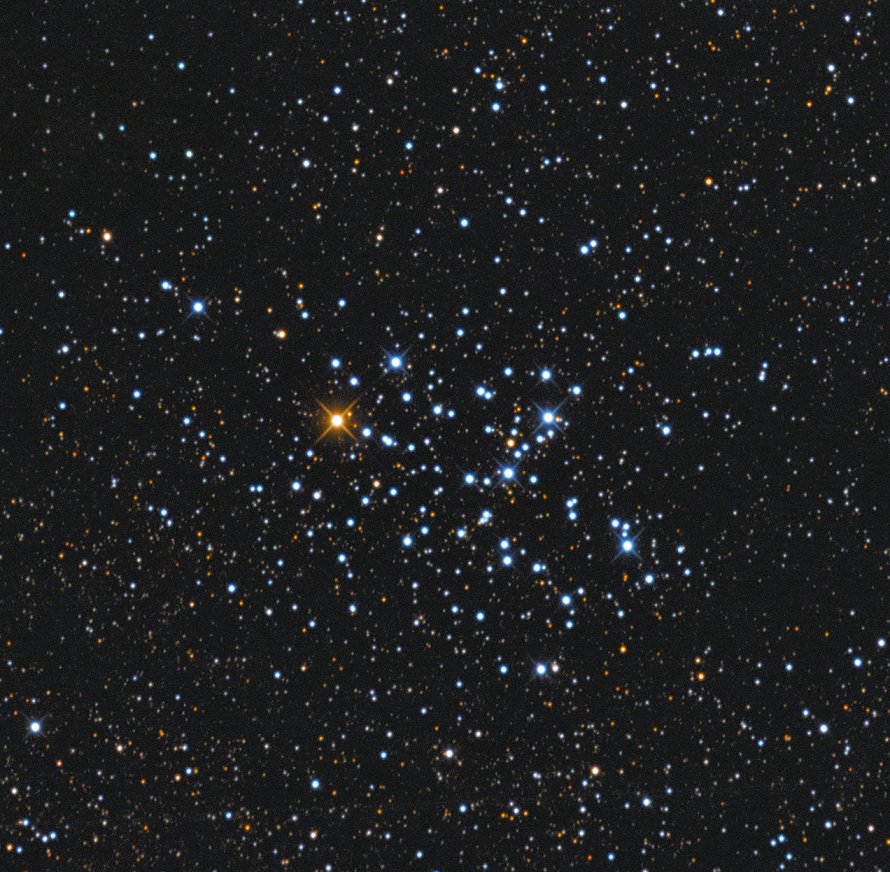M6 (NGC 6405) - Butterfly Cluster
Messier 6 (NGC 6405), also known as the Butterfly Cluster, is an open cluster located in the constellation Scorpius, in the Orion Arm of the Milky Way Galaxy in the Local Group of galaxies. M6 is 1600 light years away from Earth.
M6 is best viewed during mid-summer, is magnitude 4.2, and can be viewed with naked eye. M6 is 25' in apparent size. For reference, the full moon is 30'.
Observing difficulty: Easy
- Name:
- Butterfly Cluster
- Type:
- open cluster
- Constellation:
- Scorpius
- NGC or IC:
- NGC 6405
- Magnitude:
- 4.2
- Viewing:
- naked eye
- Size:
- 25'
- Distance (light years):
- 1600 LY
- RA:
- 17h 40.1m
- Dec:
- -32 13'
- Season:
- mid-summer
- Milky Way location:
- Orion Arm
- Galaxy group:
- Local Group
- Messier Marathon #:
- 86
* The naked eye can see up to magnitude ~7-8 objects under ideal dark sky conditions.
The Butterfly Cluster's Cosmic Dance
Messier 6, or the Butterfly Cluster, is an open star cluster in the Scorpius constellation. As an easily observable and intriguingly structured celestial object, M6 provides scientists with valuable information about stellar evolution and galactic structure. This article presents a detailed and technical exploration of the Butterfly Cluster.
Discovery and Observation
Messier 6 was cataloged by Charles Messier in 1764, though it was likely known to earlier astronomers due to its visibility to the naked eye. Its moniker, the Butterfly Cluster, is a nod to its distinctive shape, reminiscent of a butterfly with its wings spread. At a distance of about 1,600 light-years, M6's bright stars can be easily seen with naked eye.
Physical Characteristics
M6 covers a region of space about 20 light-years across. It is composed of roughly 300 confirmed members, but the overall number is likely much higher when considering less luminous or obscured stars. The cluster's brightest star, BM Scorpii or HD 160371, is a class B8 giant with an apparent magnitude of 5.5 and provides much of the cluster's overall luminosity. M6's position in the sky places it near the galactic plane, offering an excellent backdrop of countless distant Milky Way stars.
Stellar Composition
The Butterfly Cluster is relatively young compared to the universe's age, with an estimated age of 75-100 million years. Consequently, its stars exhibit a higher metallicity than older globular clusters. The most common stars in the cluster are hot, luminous class B and A-type stars, but M6 also hosts cooler G-type stars, similar to our Sun. The range of stellar types in M6 allows astronomers to study various stages of stellar evolution simultaneously.
Unique Features and Phenomena
Among M6's unique features are its variable stars, especially the slowly pulsating B-type (SPB) star, BM Scorpii. SPB stars are high-mass stars that exhibit photometric variability due to multiple non-radial pulsation modes, and they represent an essential class of objects for the study of stellar oscillations. Observations and study of BM Scorpii contribute to our understanding of this pulsation phenomenon and the broader field of stellar astrophysics.
Scientific Significance
As an open cluster, M6 serves as an important tool for studying stellar dynamics, evolution, and the structure of our galaxy. By examining the characteristics of M6's stars - their composition, mass, brightness, and other physical properties - astronomers can infer the conditions of the interstellar medium at the time of the cluster's formation. The information gleaned from clusters like M6 also contributes to our understanding of the galactic disc's large-scale structure and star formation history.
Apparent Magnitude and Distance
With an apparent magnitude of approximately 4.2, Messier 6 is easily observable to the naked eye in a dark sky, making it one of the brightest open clusters. The Butterfly Cluster is located relatively close to Earth, at a distance of about 1,600 light-years. This proximity further enhances its brightness and makes it an outstanding object for observational astronomy.
Finding and Observing Messier 6
The Butterfly Cluster is situated in the constellation Scorpius, a prominent constellation of the southern sky that's well-known for its distinctive scorpion-like shape. More specifically, M6 is located near the top of the scorpion's curved "tail." This makes it relatively easy to locate, especially during summer months when Scorpius is high in the sky for observers in the Southern Hemisphere and those in the southern parts of the Northern Hemisphere.
Under clear skies and with little to no light pollution, M6 can be seen with the naked eye as a hazy patch of light. With binoculars or a small telescope, the cluster's individual stars become resolvable, revealing the beautiful butterfly shape. Larger telescopes will offer a more detailed view, showing a rich field of stars against the background of the Milky Way.



